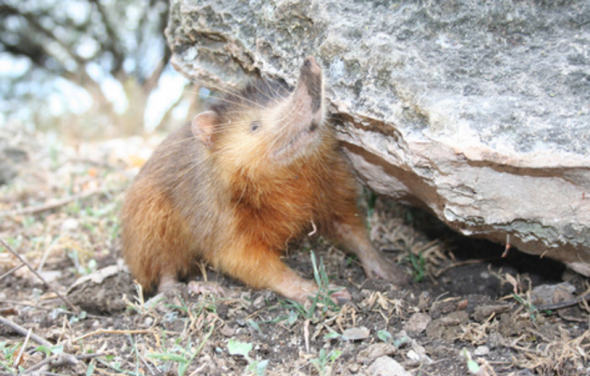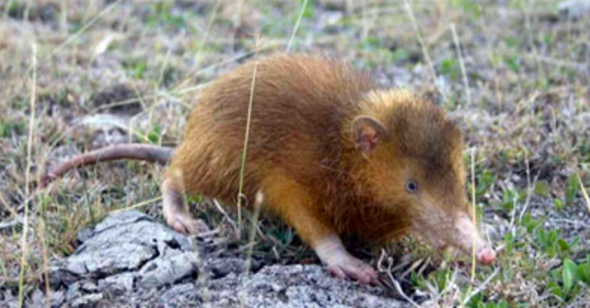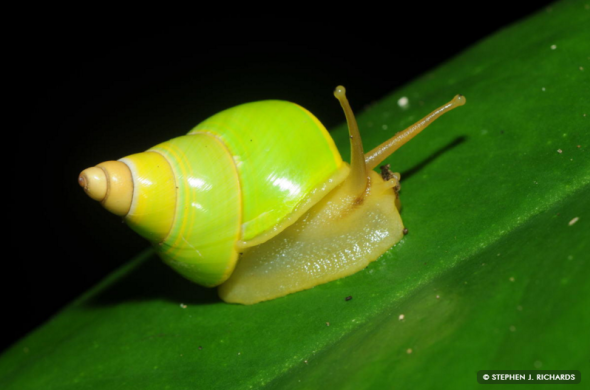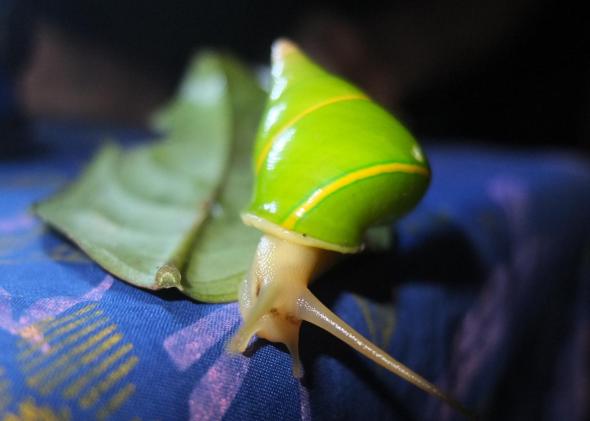Endangered Species Monday | Potorous gilbertii - Back From The Brink Of Extinction.
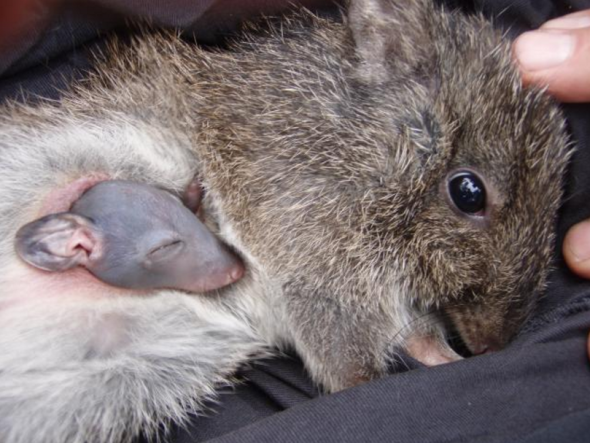
Endangered Species Monday | Potorous gilbertii
This Monday’s (ESP) post, I’ve decided to document a little more on Australia’s wildlife. This Monday I have dedicated this post to one of Australia’s most endangered marsupials. Commonly known as the Gilbert’s Potoroo. (Image Credit Parks and Wildlife Australia).
Identified as the worlds ‘rarest marsupial’, the species is scientifically known as the Potorous gilbertii. Listed as (critically endangered) the species was primarily identified back in 1841 by Dr John Gould FRS - 14 September 1804 – 3 February 1881) who was a British ornithologist and bird artist. He published a number of monographs on birds, illustrated by plates that he produced with the assistance of his wife, Elizabeth Gould, and several other artists including Edward Lear, Henry Constantine Richter, Joseph Wolf and William Matthew Hart.
Dr Gould has been considered the father of bird study in Australia and the Gould League in Australia is named after him. His identification of the birds now nicknamed “Darwin’s finches” played a role in the inception of Darwin’s theory of evolution by natural selection. Gould’s work is referenced in Charles Darwin’s book, On the Origin of Species.
Life hasn’t been at all easy for the P. gilbertii. It was only back in 2012 that conservation and environmental scientists (rediscovered) the species of which it was believed the marsupial had gone completely extinct within the wild. Endemic to Australia there is very little known in relation to when threats came about, increased and decreased. However I can state now; as small as populations are known - P. gilbertii’s populations are ‘currently stable within the wild’.
While though populations are stable, there are only thirty to forty actually known to be living within their endemic wild, so there is still a large amount of concern for the worlds most endangered marsupial. Back in early 1980’s the species had been listed as (completely extinct within the wild after studies from the 1800’s turned up nothing). Fortunately though environmental scientists went on the prowl and were not under any circumstances ready to write this species off whatsoever. They were technically looking for an animal that hadn’t been seen since the 1880’s-1990’s. Their work though eventually paid off.
“THEN CAME A BREAK THROUGH IN 1994”
Environmental scientists come 1992-1993 were ready to write the species off, call off all explorations and projects that were aimed at hopefully rediscovering the species. Fortunately though the Australian Parks and Wildlife Service persisted - and come 1994 a spotting was recorded. After so many years believing the Gilbert’s Potoroo had gone extinct, scientists discovered an extremely small population - to the joy of many. Finally there was hope, and today the species remains under full governmental protection.
Native to South-western and Western Australia the remaining populations was taken by three collectors between 1840 and 1879 in the vicinity of King George’s Sound (Albany), but exact locations are unknown. Skeletal material is common in cave deposits between Cape Leeuwin and Cape Naturaliste. Sub-fossil skeletal specimens have been located in coastal sand dunes between these localities. It is currently restricted to Mt. Gardner promontory in Two Peoples Bay Nature Reserve.
The entire population (consisting of 30-40 mature individuals) as explained above remains inhabits the Two Peoples Bay Nature Reserve of which they enjoy protection from the local parks wildlife board. While populations are identified as extremely small, mother will give birth to either 1-2 babies every year, normally its 2 babies. Like kangaroos the species has the ability to keep a second embryo in a state of diapause while the first embryo is growing. If the first baby does not go to term, a second baby starts growing right away.
Check out the Gilbert’s Potoroo Action Group by clicking this link
Diapause is considered a rare phenomena - especially in kangaroos, although its been witnessed quite a lot over the past few years by European, British and Australian Zoologists. The last diapause event (that I’m aware of) was witnessed at the Taronga Zoological Gardens in Australia. You can read the story >here.< The gestation period for Gilbert’s potoroo is unknown, but is estimated to be similar to the long-nosed potoroo at 38 days.
Since so few are alive today, much of the reproductive cycle for Gilbert’s potoroo remains unknown. However, the main breeding period is thought to be November–December with similar breeding patterns to those of the long-nosed potoroo. Scientists have tried to breed them in captivity, but recent attempts have been unsuccessful, citing diet, incompatibility, and age as possible factors that influenced the lack of reproduction. Reproduction in the wild is thought to be progressing successfully as many females found in the wild are with young.
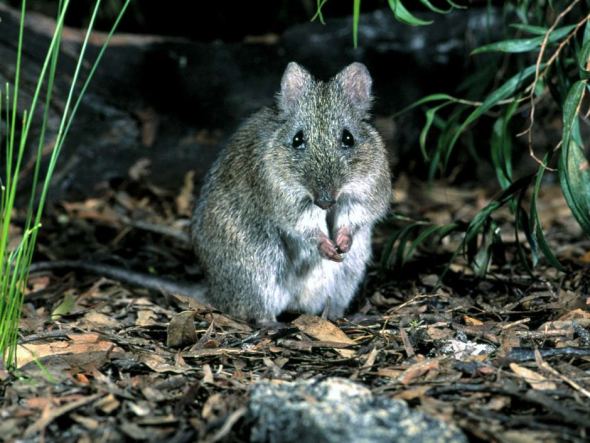
Image: Gilbert’s Potoroo. Photographer Mr Dick Walker.
In 2001, the Gilbert’s Potoroo Action Group was formed to help in the education and public awareness of the potoroo. The group also helps with raising funds for the research and captive-breeding programs for Gilbert’s potoroo. In efforts to protect the remaining population, three Gilbert’s potoroos (one male and two females) were moved to Bald Island in August 2005, where they are free from predation. Since that time, an additional four potoroos have been sent to establish a breeding colony.
THREATS
Fire is the critical threat (present and future) to this species as the Mt. Gardner population is in an area of long unburnt and extremely fire prone vegetation, and a single fire event could potentially wipe out the species (except for the few individuals in captivity and on Bald Island). This species is in the prey size range of both feral cats and foxes, and both are known to exist in the Two Peoples Bay area, thus this species is likely threatened by these predators.
Maxwell et al. (1996) states that the reasons for the decline of the species are unknown. Predation by foxes has probably been significant. Changed fire regimes may have altered habitat and/or exacerbated fox and cat predation by destroying dense cover. Gilbert’s notes record it as “the constant companion” of Quokkas, Setonix brachyurus
Unlike Gilbert’s Potoroo, the Quokka, although declining, persists over much of its pre-settlement range. The difference has not been explained. Maxwell et al. (1996) and Courtenay and Friend (2004), suggest that dieback disease caused by Phytophthora cinnamomi threatens persisting populations by eliminating plant symbionts of hypogeal, mycorrhizal fungi which are the principal food of Gilbert’s Potoroos. Altering vegetation structure and eliminating plants that provide food are direct threats to this species.
For now and based on various accounts, research and up to data documentaries. The species is still in danger. As explained above a single large and sporadic fire within the species habitat - could kill off the entire identified populations, which would be a catastrophe. While there is minimal threat from predators such as foxes and feral cats - this could change. So the need for persistent monitoring is a must. Finally we have disease, with populations being so small at around 30-40, any single disease could like fires wipe the entire species out within a single week.
Within the article above I’ve included various links for your immediate attention and information, as well as a link to the main working group that is helping (and doing all they can) to preserve the species. Furthermore I’ve included a donation link for you to donate to the Gilbert’s Potoroo Action Group. While I’m not entirely sure whether you can volunteer, there is a link on the main website below (highlighted: Volunteer Today). Just click the link, follow the instructions and, I’m confident someone will get back to you as soon as possible.
Volunteer Today
Thank you for reading, please don’t forget after reading to share this article, and hit the like button too.
Dr Jose Carlos Depre Depre PhD. MEnvSc. BSc(Hons) Botany, PhD(NeuroSci) D.V.M.
Environmental & Human Science
Endangered Species Friday | Bubalus mindorensis | Asia’s Next Extinction!
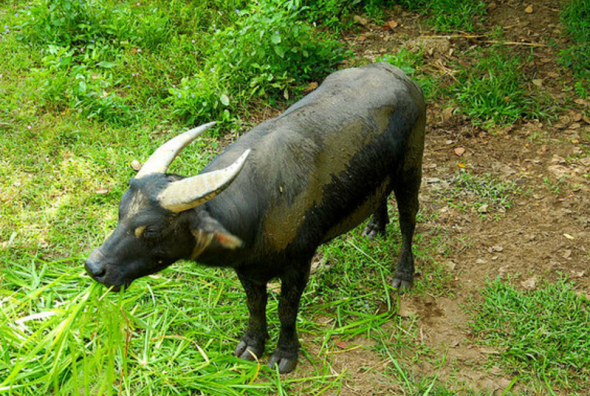
Endangered Species Friday | Bubalus mindorensis
This Friday’s (ESP) Endangered Species Post, I’m touching on a very undocumented species of buffalo that is so endangered - its extremely likely the species will go extinct within the next ten years maximum. (Photographer unidentified).
Listed as (critically endangered) the species was primarily identified back in 1888 by French born Dr Pierre Marie Heude (25 June 1836 – 3 January 1902) whom was a French Jesuit missionary and zoologist. Born at Fougères in the Department of Ille-et-Vilaine, Heude became a Jesuit in 1856 and was ordained to the priesthood in 1867. He went to China in 1868. During the following years, he devoted all his time and energy to the studies of the natural history of Eastern Asia, traveling widely in China and other parts of Eastern Asia.
Endemic to the Philippines B. mindorensis first came to the attention of environmentalists when conservationists began studying the Mindoro Water Buffalo in the early 1940’s of which they found insufficient data relating to the species. Unfortunately from 1986-1996 the species was then suddenly re-listed as (endangered).
Yet the Tamaraw had been known to overseas and native conservation scientists for over THIRTY YEARS of which today we’re now seeing a possible new extinction occurring within the Philippines. How is this possible, when scientists knew about the status of the species, why hasn’t a single zoo removed small populations to house in protective breeding captivity for later reintroduction into the same habitat, or new pastures?
Meanwhile from the year 2000 to 2008 the species was again (re-listed from endangered to critically endangered). Today the Tamaraw is now bordering complete extinction within the wild, and from what we know there is ‘possibly’ no protective captivity projects anywhere around the globe to preserve the species for future reintroduction in the wild. We do hope that we’re wrong?
From what we know based on the last census from 2013 (three years ago) there was noted within the wild only 105 mature individuals remaining. This equates to exactly 105-210 mature individuals (estimate). Within the past three years its very likely we have probably lost half of the remaining populations known, which could mean there is only 52-205 mature individuals remaining within the wild to date.
The species is not known to be fragmented, however populations are still declining. The major threat was once identified as hunting, although ‘allegedly’ isn’t known to be a threat now?. As a scientist and environmental crime CEO I find this very difficult to comprehend, due to the amount of horned ungulates which are being located throughout South East Asia. I must state though: my environmental crimes officers as yet haven’t located any Tamaraw horns or trophy heads.
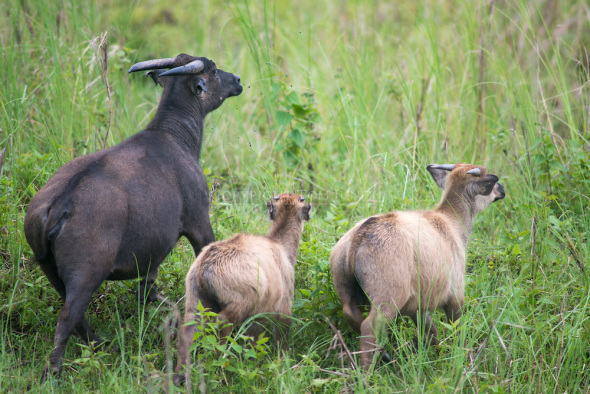
Image: Tamaraw. Credits: Ruisu Fang.
Formerly, Tamaraw were found across the whole of Mindoro from sea level to the high peaks (to over 1,800 m), inhabiting open grassland or forest glades, thick bamboo-jungle, marshy river valleys, and low to mid-elevation forests. The species is currently confined to a few remote areas over 200 m, and is most often recorded in secondary forest and mixed forest/grassland.
Tamaraw are largely solitary, although females occur with offspring. Males and females occasionally associate temporarily throughout the year, which is similar to other bovines species, such as African buffalo, banteng and gaur. The solitary nature of the species is probably an adaptation to forest habitats, where large groups would prove to be a hindrance. Tamaraw feed primarily on grasses, as well as young bamboo shoots, in open grasslands, resting within tall grasses or dense forest. Although formerly diurnal, Tamaraw have become largely nocturnal due to human encroachment and disturbance.
“WE’RE LOSING THEM, AND FAST”
I do find it quite disheartening to know that the Philippines “national animal symbol” isn’t really being preserved or even protected from nearing complete extinction, although there are some projects out there that are helping to save the species from extinction, the problem is of course, as usual, funding!. One would think that a country that’s so wealthy, and a country that has introduced so many animal, wildlife and environmental laws would at least be fighting to protect the tamaraw. From what I have read and heard from the locals - they are trying their utmost hardest, unfortunately not everyone thinks the same as many kind Filipinos.
THREATS
The main current threat to the Tamaraw is habitat loss due to farming by resettled and local people, with a high human population growth rates in and around its remaining habitat. In some areas, fires set for agriculture are a threat to the species’ habitat. Cattle ranching and farming activities pose a number of threats, including the risk of diseases spreading to the Tamaraw from livestock and burning of pastures leading to a reduced number of palatable grass species.
Historically, Tamaraw were hunted for both subsistence and sport, which led to a period of drastic decline in numbers of individuals and populations. Hunting was carefully regulated prior to World War II, but since then a growing human population, logging operations, ranching, and widespread availability of firearms on Mindoro have caused a dramatic decline in numbers.
Since the 1980s, sport hunting has reduced due to a decline in the Tamaraw population, closure of nearby ranches, and more intensive patrolling and awareness activities since the establishment of the protected area. International trade in this species or its derivatives has not been reported. Although protected by law, the illegal capture and killing of this species continues.
While its currently “illegal to poach or hunt” the species “we believe some are still being poached within the Philippines to provide horns to both China and Viet Nam”. As yet there is NO EVIDENCE to back these claims up, however I.A.R.F.A environmental crimes officers have located in Viet Nam a lot of ‘counterfeit Rhinoceros horn’, which when analysed, has proven to us the horn[s] most certainly aren’t from rhinos, but from a buffalo species. So this area of the counterfeit rhino horn trade still needs intensive investigation.
The current plight of the tamaraw is not looking good, and from our own investigations and third party environmental investigations relating to the species - extinction is very likely to occur in around five to ten years (if that).
“THE TAMARAW IS ASIA’S NEXT EXTINCTION”
Thank you for reading.
Dr Jose Carlos Depre. PhD. MEnvSc. BSc(Hons) Botany, PhD(NeuroSci) D.V.M.
Environmental, Botanical & Human Scientist.
Endangered Species Friday: Solenodon paradoxus | Extinction is Imminent.
Endangered Species Friday: Solenodon paradoxus
This Friday’s (Endangered Species Post) E.S.P, I touch up again on the Hispaniolan Solenodon, scientifically identified as Solenondon paradoxus. Image credit: Mr Jose Nunez-Mino. My reasons for re-documenting on this species is primarily due to my belief that extinction is now most certainly imminent. Therefore for that reason I think its critical that we all make as much noise as possible for this little one due to is importance within the theater of conservation, and because its one of very few mammals that do actually host a venomous side to them.
Written by Dr Jose C. Depre; Botanical and Conservation Scientist.
Solenondon paradoxus was identified back in 1883 by Dr Johann Friedrich von Brandt (25 May 1802 – 15 July 1879) was a German naturalist. Brandt was born in Jüterbog and educated at a gymnasium in Wittenberg and the University of Berlin. In 1831 he was appointed director of the Zoological Department at the St Petersburg Academy of Sciences, where he published in Russian. Brandt encouraged the collection of native animals, many of which were not represented in the museum. Many specimens began to arrive from the expeditions of Severtzov, Przhevalsky, Middendorff, Schrenck and Gustav Radde.
Listed as (endangered) the species is endemic to the Dominican Republic; Haiti. Back in 1965 the species was re-located and reassessed of which scientists agreed the species ‘required watching due to concerns relating to low population levels’. Unfortunately, and despite the species then being known as severely threatened, from 1982-1996 the Solenondon paradoxus was re-listed as (endangered), now nearing almost complete extinction within the wild. It is without a doubt that we may be seeing this stunning “slotted tooth mammal” extinct within the next two to three years. The name Solenodon means ‘slotted tooth’ of which this insectivorous mammalian is known to be (venomous).
Population levels within the wild have been identified as (severely fragmented), and a population decrease within the species native wild has been ongoing since the early 1980’s, the mammal-like-shrew is considered to be extremely rare. Furthermore within Haiti the species “could be considered as critically endangered” due to an isolated population that covers only 100 kilometers square. Habit loss and persecution are the primary threats associated with the species.
The Haitian solenodon as the species is commonly known to the locals resides mainly next to plantations, forest and brush country. The species leads a mainly nocturnal life where it hides among rock clefts and under large stones, dark caves or hollow trees. Diet atypically consists of insects, but mainly spiders which the species digs from the ground and leaf litter. Small frogs and reptiles are also known to be part of the mammals diet. Haitian solenodon will use its long snout to sniff out food even buried deep into the ground then its powerful claws to locate food via burrowing which are about 2-4cms long, a venom will if required be administered to much larger prey.
The species is relatively social and does not live a solitary life, its been noted that the species prefers to live within groups of 5-8 within underground burrows, which is almost similar to the European moles behavior. Gestating females will normally give birth to 1-2 young and no more, young will always be born within the main family burrow. Young will remain with their mother for approximately seven to eight months, from which after maturity they are left to fend for themselves, however its been documented that the young and parents will ‘sometimes socialize and live together’.
Image credit: Mr Jorge Brocca
Currently under Dominican Republic law the species is protected under the General Environmental Law of 64-00. A recovery plan was published back in 1992 aimed at improving surveys, and management of the National Park Pic Macaya followed up with educational plans to help reduce species populations decline. A further implementation within the protection plan was to decrease exotic animal sales of the mammal and address these main issues wildly over the animals range.
Unfortunately since 1992 nothing “hard hitting” has been put into practice, and its quite likely that should anyone of the actions now be played out - its most likely to have no affect whatsoever due to the species now bordering complete extinction within the wild. However I myself do believe that we can only but try create as much noise as possible, applying pressure where needed thus forcing the Haitian Department of Environment, and Government to now protect this specie and implement whatever actions necessary to preserve this mammalian and its current habitat.
Major Threats
The most significant threat to this species appears to be the continuing demise of its forest habitat and predation by introduced rats, mongoose, cats and dogs, especially in the vicinity of human settlements. In Haiti persecution and hunting for food is a major threat, and there is devastating habitat destruction also occurring.
Venom Warning
Despite the fact humans and other predators prey on the animal, and the fact this animal is rather small, Solenondon paradoxus does indeed pack a small “unknown venomous punch”, and you’d not really want to be bitten by this little one. I cannot emphasize the importance of wearing “protective clothing in the way of gloves” should you come into contact with this animal. Venom is administered in more or less the same manner as snakes administer their venom (not poison). Please note there is a very big difference between (venom and poison).
The solenodon is particularly fascinating because it delivers its poison just as a snake does—using its teeth as a syringe to inject venom into its target. Not a lot is known about these unusual mammals. There are only two solenodon species: One lives on Cuba and the other on Hispaniola (home to Haiti and the Dominican Republic). At night when the species goes in search of food venom would typically be administered to more larger prey such as frogs, and smaller reptilians that the animal also feeds on, despite the animals diet mainly consisting of insects. While the venom is not “considered dangerous to humans” there is actually no hard hitting evidence that its venom is or isn’t dangerous.
The reason I state that, is because most handlers within zoological gardens do actually wear gloves in order to protect themselves from being bitten. So theoretically speaking it would be considered safe to say that while little is known about the animals venomous side - please wear gloves should you come into contact with the animal until more data can be located on the animals venom Etc.
There remains no current data in relation to how many mature and non-mature solenodon individuals there are within the wild, furthermore little is known about life expectancy, however locals have stated local populations can/have lived for up-to 5-7 years.
I am unsure what the future holds for this rather peculiar animal, its one of very few mammals that do actually have the ability to administer a venomous bite via its salivary glands too. The Hispaniolan solenodon represents a remarkable amount of unique evolutionary history, diverging from other living mammal groups some 75 million years ago and before the extinction of the dinosaurs. Conservation efforts don’t seem to be improving the animals population levels, however I am told that conservation actions have been planned. Will they work though now is another story.
The clock is ticking fast for this little one…While I want to believe that we can do something I do believe that its probably too late. Therefore I predict that my next document on this species will be informing the general public of its wild extinction. That would be considered quite sad to be fair regarding my look at things. Check out the video below.
“EXTINCTION IS IMMINENT”
Thank you for reading.
Dr Jose C. Depre. PhD. MEnvSc. BSc(Hons) Botany, PhD(NeuroSci) D.V.M.
Environmental, Botanical and Human Science.
Follow me on Twitter: https://twitter.com/josedepre11
Donate via our Facebook button: https://www.facebook.com/Anti-Pet-and-Bush-Meat-Coalition-474749102678817/app/117708921611213/
Sign up here: https://www.facebook.com/Anti-Pet-and-Bush-Meat-Coalition-474749102678817/app/100265896690345/
Whatever you do may seem insignificant to you, but its most important that you do it!
Endangered Species Monday: Papustyla pulcherrima | Special Report.
Endangered Species Monday: Papustyla pulcherrima
Manus Green Tree Snail - Very first invertebrate to be listed on the Endangered Species Act of the United States of America (2015) Endangered Species Post Special Report.
This Monday’s Endangered Species Post (ESP) I take a wee glimpse into the life of the Green Tree Snail, also commonly known by Papua New Guinea’s natives as the Manus Green Tree Snail. Image Credit: Stephen J. Richards.
Identified by Professor Rensch 1931, Rensch was born on the 21st January 1900 in Thale in Harz and died on the 4th April 1990 in Münster, (Germany), Professor Rensch was an evolutionary biologist, zoologist, ethologist, neurophysiologist and philosopher and co-founder of the synthetic theory of evolution. He was professor of Zoology and Director of the Zoological Institute at the Westphalian Wilhelms University in Münster. Together with his wife Mme Ilse Rensch he also worked in the field of Malacology and described several new species and subspecies of land snails.
The Manus Green Tree Snail is identified as Papustyla pulcherrima commonly known as the Emerald Green Snail. From 1983-1994 this particular species of snail was considered (extremely rare). Back in 1996 when scientists managed to again finally catch up with this stunning little mollusk, the species was then listed as (data deficient) of which to date there remains little information about this (rare) but beautiful snail.
P. pulcherrima is endemic to the Papa New Guinea northern island of Manus of which the species is listed as (near threatened), and has also been reported on the adjacent Los Negros Island. Environmental scientists have confirmed from villagers on the main Manus Island that the species is not located anywhere else. However there are some sketchy reports that the species “may be located on surrounding islands”, however there is no evidence to back these claims up.
Environmental scientists have confirmed for now that the species is located in only 12-13 areas of the Manus Island[s]. Further reports have confirmed that mature individuals are on the decline (which if not controlled could evidently see the species re-listed as vulnerable or endangered). The Manus Green Tree Snail is not believed to be living within fragmented zones. The species is restricted to forest and low intensity garden ‘type’ habitat. Declines have been noted within all 12-13 identified habitats on the Manus Island and adjacent Los Negros Islands. Population history is pretty much undocumented although has been shown to be slowly declining.
Image: Manus Green Tree Snail.
Back in 1930 when Professor Rensch identified the Manus Green Tree Snail, locals soon began collecting the species for trade thus seeing the mollusk now nearing endangered listing. Demand for the Manus Green Tree Snail has now drastically increased threatening the species furthermore. Locals continue to collect this rather unusual colored species shell for use within the jewelry trade. There are now “very serious concerns” that trade may eventually push the species into extinction.
Due to mass trade exploitation the Manus Green Tree Snail is the very first invertebrate to be listed on the Endangered Species Act of the United States of America. International trade has been controlled by export permit since 1975 under the Convention on International Trade in Endangered Species of Wild Fauna and Flora (CITES) appendix II. Unfortunately this is not stopping locals from harvesting the species, and trade is still continuing despite it now a criminal offence under United States and some international laws.
“Overexploitation threatens the Manus Snail”
Market sales data collected from the Lorengau market, over a six day period suggest that annual sales at the market may approach 5,000 shells. Investigations by the Wildlife Conservation Society (WCS) reveal that large quantities of shells are still being attempted to be exported out of the country. Online searches revealed the sale of the shells, often marketed as antiques, occurring in open forums and internet market places based in New Zealand, Australia, and the United States of America (USA). International Animal Rescue Foundation has ran numerous traces online of which located yet again Ebay as being a number one trading site of the “threatened species”, please view the image below and click the image link that’ll direct you to that site.
“EBAY JAPAN IS A HOTBED FOR ILLEGAL TRADE OF THE MANUS GREEN SNAIL”
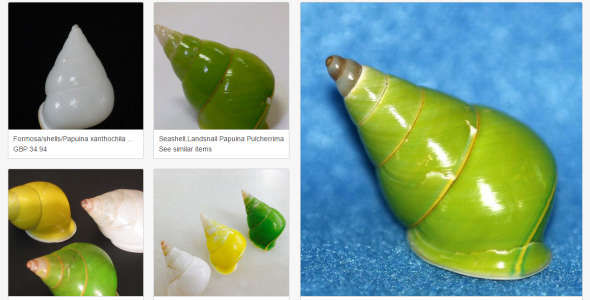
International Animal Rescue Foundation’s External Affairs Department and the Environmental Cyber Crimes Unit located many a sites trading the Manus Green Tree Snail’s shell which is illegal under some trade law, unfortunately the Ebay site listed above, located within Japan is one of many more that are trading (despite the species nearing extinction).
I.A.R.F’s Environmental Cyber Crimes Unit have since filed a complaint with Ebay, providing all the relevant data to now remove these species from their sites, however its likely to prove negative as the trader could very well state they harvested or purchased the shells before international laws were drafted. Furthermore a trace of the owner that owns this site above which is in violation of the United States and Cites laws (is located within the United States). So in regards to enforcement, breaking this link is going to be somewhat of a tough cookie. Further trade was witnessed here via what we can only believe is alleged “antiques”.
Further trade all of which is illegal has been recorded hereto - this site linked back to a Mr Rob West of 121 Henderson Road, Sheldon, Brisbane, Queensland 4157 Australia, Telephone: 610732061636. Mr West from Brisbane categorically states that he doesn’t own a shop, and is a one man band, yet clearly this link states otherwise. Further evidence revealed antique trade conducted on the Ebay site, see in the image below (illegal under United States law).
Click the image link below to view more.
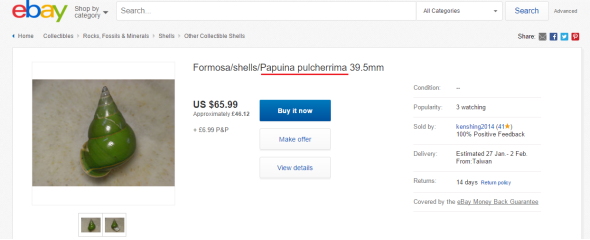
“Illegal to trade under the Endangered Species Act of the United States of America”
The environmental wildlife crimes investigation team linked to TRAFFIC and Cites stated:
It is possible the avoidance of conventional nomenclature is an attempt to avoid detection by authorities. In some cases, sellers on internet market places were based in CITES signatory countries (including: Australia, Italy, New Zealand, Singapore and USA) while others were not (e.g. Taiwan). Currently, volumes of shells on sale in such online market places appear low, suggesting that the existing controls on international trade maybe adequate. However, given that the online prices of shells were often orders of magnitude greater than market prices on Manus Island, vigilance will be required to insure that illegal international demand does not fuel a resurgence in snail collection.
Despite the massive trade on Manus Green Tree Snails online and within open Asian markets, its literally impossible to determine if this trade will eventually lead to the species being pushed into extinction. However it MUST be noted that there are currently only 12-13 identified habitats that the snail currently inhabits. And based on traces online conducted by the I.A.R.F’s External Affairs Department - trade is most certainly “out of control”, and not as Cites has reported (2012).
The shell of this species is a vivid green color, which is unusual in snails. The green color is however not within the solid, calcium carbonate part of the shell but instead it is a very thin protein layer known as the periostracum. Under the periostracum the shell is yellow.
MAJOR THREATS
The Manus Green Tree Snail is mostly threatened by habitat destruction through forest clearance: logging, plantation development (especially rubber) and to a lesser extent road developments. Increasing human population growth and an increasing cultural demand for deriving cash incomes from the land will likely see the rate of forest degradation increase in the future. Harvest occurs when trees are felled as part of traditional shifting cultivation and the snails, typically found in the canopy, suddenly become exposed. Such harvesting is not uncommon but it is likely to be of lower significance than the longer term habitat degradation caused by such agricultural practices.
While harvest for illicit international trade is occurring, the volumes are not “allegedly” thought to be large compared to historic rates, although they may approach levels seen in the legal domestic trade. However, given that the prices of shells internationally are often orders of magnitude greater than market prices on Manus Island, vigilance will be required to insure that illegal international demand does not fuel a resurgence in snail collection.
Notable deposits of gold have been found in central Manus and a mine operation will likely result in the next decade although no details of the plan have been released (as of 2014). The forests of Manus Island were badly affected by the 1997-1998 El Niño which resulted in a prolonged drought. Should climatic change result in increased rates of similar conditions this may constitute a future threat to the snail species, however, current predictions suggest that future incidence of drought in Papua New Guinea will decrease (Australian Bureau of Metrology and CSIRO 2011).
Despite the reassurances from Cites, WCS and the local wildlife organisations - evidence clearly points to large scale online trade legal and illegal. Furthermore there is no telling if shells online are antique or smuggled from the Manus Islands which is very concerning.
Manus Green Tree Snail is the first such snail to be listed on the threatened list of endangered species (USA). Research also explains to us that its likely the species will be plundered into extinction - very soon. Enjoy the video.
Thank you for reading, and please be most kind to share to create awareness and education.
Dr Jose C. Depre PhD. MEnvSc. BSc(Hons) Botany, PhD(NeuroSci) D.V.M.
Environmental & Human Science
Donate by clicking the link below:
https://www.facebook.com/Anti-Pet-and-Bush-Meat-Coalition-474749102678817/app/117708921611213/
Sign up here to our A.P.B.M.C news feed below here:
https://www.facebook.com/Anti-Pet-and-Bush-Meat-Coalition-474749102678817/app/100265896690345/
Follow me on Twitter here:
https://twitter.com/josedepre11
Sources:
IUCN, WWF, CITES, WCS, Ebay, Wikipedia, Australian Bureau of Metrology and CSIRO

